Duomo Architecture | Last Judgment | Location | Opening Hours Tickets | Authorizations
The Duomo Santa Maria del Fiore, Saint Mary of the Flower, the Florence Basilica in Florence in Italy
Unique dimensions for the time
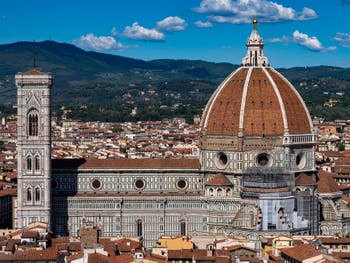
Florence Duomo This Gothic cathedral is imposing!
It is 155 metres long, beaten anyway by the basilica of St. Peter in Rome (186 m), but longer than St. Paul's Cathedral in London (152 m), the Duomo of Milan (153 m) or even Notre Dame de Paris (130 m).
For a few centuries, it was the largest Christian cathedral in the world before the papacy decided to expand the basilica of St. Peter in Rome to be larger than the cathedral of Florence.
It measures, from one end to the other of the transept: 90 metres and, from the ground to the top of the dome's lantern: 107 metres!
The Dome of Brunelleschi
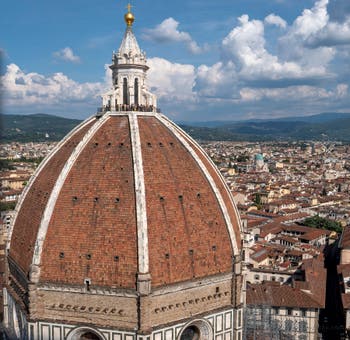
Florence Duomo The cathedral stayed open, without a dome, for nearly 40 years before an engineer architect, Filippo Brunelleschi, was able to design architecture at the limits of physical possibilities for such a diameter and height.
It was completed in 1420.
To achieve this, Brunelleschi took inspiration, among other things, from the dome of the Pantheon of Rome and had the idea of a double cap, both inside and outside, which rely on each other, creating an octagonal dome, eight-sided, which further strengthens the structure.
The idea of this support between the two caps also made it possible to build the dome without having to use arches during its erection, which also simplified the construction phase.
It seems simple, but at the time, it was a real tour de force, never seen in these dimensions, and Brunelleschi's genius even went so far as to ensure that the final strength of his dome is... in the lantern.
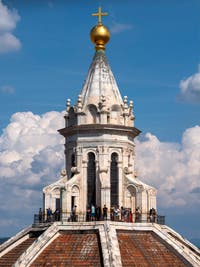
Florence Duomo In addition to its beauty, this marble lantern crowns sublimely the cathedral's dome and has a static function that stabilizes, thanks to its weight, the dome's fence ring.
But the final laying of the lantern invented by Brunelleschi was made only in 1468.
It was carried out by Andrea del Verrocchio, the master of Leonardo da Vinci, who also made the colossal bronze ball topped by a cross that dominates the dome.
The inner diameter of the circle inscribed in the dome's octagon is 41,90 m, compared with that of the Pantheon in Rome, which is 42,70 m.
The inner cap has a thickness at its base of 2.20 m and 2 m at the top of the dome.
The outer cap is thinner since it starts at 96 centimetres to end at 40 centimetres.
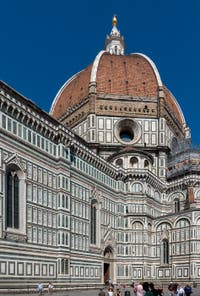
Florence Duomo All this gives an idea of the complexity of creating this dome and the calculations made by Filippo Brunelleschi to realize it.
From the ground to the fence ring of the sides of the inner dome, there are 86,70 m.
From the ground, but this time up to the lantern support side's base, there are 91 metres.
Finally, the total height from the ground is 107 metres.
Great art that can still be admired more than 600 years later!
Florentine artists' ability to find technical and aesthetic solutions for building this dome was the first significant Renaissance architecture affirmation.
Construction of the Cathedral of Santa Maria del Fiore, Nave, Choir and Facade
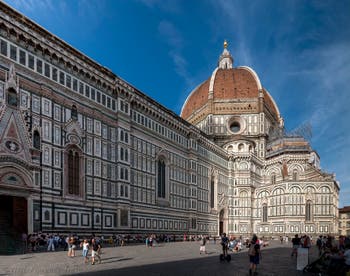
Florence Duomo The cathedral construction began on September 8, 1296, at the location of the Basilica of Santa Reparata, which became too small.
At the same time, it was decided that the cathedral would now be called Santa Maria del Fiore, a name that brings together the mother of God with the symbol of Florence, the lily.
However, the Florentines continued to call their cathedral named Santa Reparata. It took a decree of the Signoria of April 22 1412, to compel them to call it its new name Santa Maria del Fiore.
Work began under architect Arnolfo di Cambio's direction, who succeeded Giotto, Andrea Pisano and Francesco Talenti.
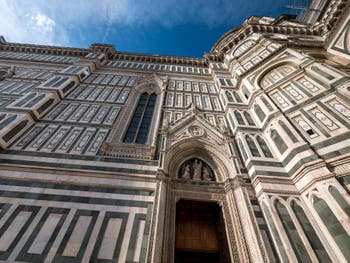
Florence Duomo Many architects, but it should also be noted that its construction was only completed 140 years later.
The economic crisis experienced by Florence at that time is, in fact, the main factor in this long construction period.
Consecration of the Cathedral on March 25, 1436
The Cathedral of Santa Maria del Fiore was consecrated on March 25, 1436, by Pope Eugene IV.A special date since in the Florentine calendar of the time, March 25 was the first day of the year. Let us remind that March 25 is the day of the Annunciation of Christ to the Virgin Mary.
The Facade of the Duomo of Florence
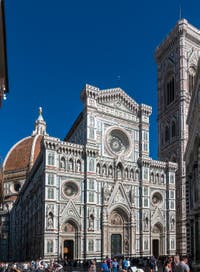
Florence Duomo The facade's construction was initiated by Arnolfo di Cambio, but it was never completed, and the little that had been built was destroyed in 1588.
Several competitions were launched to create the Duomo's facade, including by Laurenzo the Magnificent, but none of them succeeded.
The different facade plans of Santa Maria del Fiore are exhibited at the Museum of the Duomo's Works in Florence.
The current facade was built between 1871 and 1887 on Emilio de Fabris's plan and completed after his death by Luigi del Moro.
Augusto Conti is at the origin of the iconographic symbolism of the present facade's decorations on the theme of the greatness of Christianity and the meaning of the Virgin Mary.
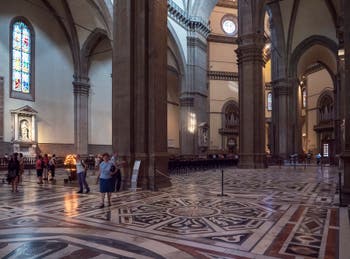
Duomo's Polychrom marble floor The bronze gates that depict Mary's life date back to the end of the 19th century and are the work of Giuseppe Cassioli and Augusto Passaglia.
The buttresses' niches' sculptures depict Cardinal Valeriani, Bishop Agostino Tinacci, Pope Eugene IV and Sant'Antonino, Bishop of Florence, from left to right.
A place of worship, but also of assembly
Imagine the Florentines, gathered in this cathedral that served as much as a place of worship as a place of gathering, listen to the readings given here of Dante's Divine Comedy.The Council of 1439 stood here and culminated in the decree of reunification with the Eastern Church.
The interior of the Cathedral of Santa Maria del Fiore in Florence
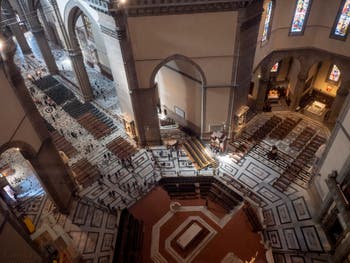
Florence Duomo The cathedral is in a longitudinal plan with a Latin cross and a central plan with the dome.
The longitudinal plane is divided into three naves supported by eight large clustered pillars on which the four oval arches rest.
The floor is covered with polychrome marbles on the project of Baccio d'Agnolo.
From 1526 to 1560, the work initiated by Baccio was taken over by his son Giuliano d'Agnolo and then by Francesco da Sangallo.
Three circular windows open on the inner side with stained glass windows by Lorenzo Ghiberti depicting San Lorenzo and the angels, the Assumption of Mary, Santo Stefano and the angels.
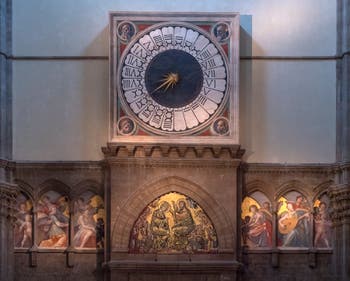
Clock and Musician Angels At the corners of the clock face are the prophets' heads, a work by Paolo Ucello made in 1443.
In the lunette above the entrance gate, a mosaic of the early fourteenth century, attributed to Gaddo Gaddi, depicts the Virgin's coronation.
On the sides of the lunette are musician angels, probably made by Santi di Tito at the end of the sixteenth century.
To the central gate's right is Antonio Orso's tomb, bishop of Florence who died in 1321, created by Tino di Camaino.
Right nave of Florence Duomo
In the first span, near the first pillar, one can admire a 14th-century Tuscan art stoup topped by an angel.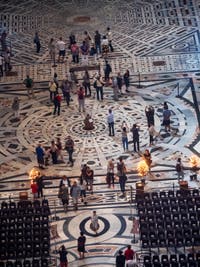
Duomo's marble floor In the second span near the bell tower's door, you can see a wood painting by Rosselló di Jacopo Franchi with San Bartolomeo on a throne.
This work dates back to 1408.
In the background is the Florence Baptistery of San Giovanni Battista, Saint John the Baptist.
In the third span, in the marble niche, one can see the prophet Isaiah's statue of Bernardo Ciuffagni realized in 1427.
On either side of the prophet Isaiah, one can see two frescoes.
The first on the right, depicting the funerary monument of Fra' Luigi Marsili, dating from 1439 and on the left, the funerary monument of Pietro Corsini, Archbishop of Florence, by Lorenzo di Bicci, realized in 1422.
Left nave of the Florence Duomo
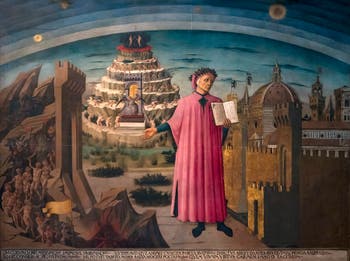
Dante and Its Worlds One can see in the left nave the famous “Dante and his worlds”, a wood painting by Domenico di Michelino (1465) which is a tribute to the great Florentine poet and a reference to the public readings of the Divine Comedy that took place in Florence Cathedral.
The cathedral is represented here, and the Palazzo Vecchio Tower and Giotto's Campanile (Bell Tower).
To the left of Dante, you can see the Hole of Hell, the mountain of Purgatory and the graduated heavens of Paradise.
In the marble niche to the left of “Dante and Its Worlds” is King David's statue.
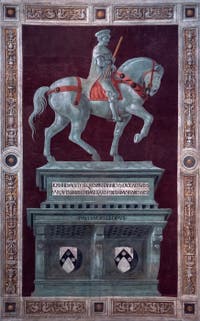
Uccello, John Hawkwood This work was done by Bernardo Ciuffagni in 1434.
To the left of David's sculpture is a fresco from 1395 depicting the equestrian monument of Giovanni Acuto.
His real name was John Hawkwood.
This English condottiere was also condottiere of the Florence Army from 1377 to 1434, the year of his death.
In the second span, one can see the mural of the equestrian monument of another soldier.
This equestrian monument is the one of Niccolo da Tolentino, whose real name Niccolo Maruzzi was captain-general of the Republic's militias and condottiere of the Florentines to the Battle of San Romano in 1432.
This fresco made in 1455-1456 is the work of Andrea del Castagno.
Under the Dome, the Choir of Santa Maria del Fiore
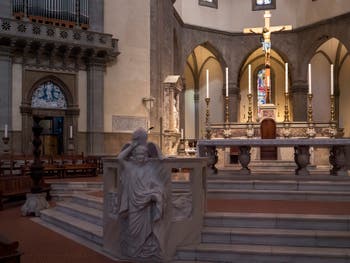
Choir of Santa Maria del Fiore Octagonal in shape, like the dome, it is delimited by a marble fence dating from the middle of the 16th century.
Around the choir are three large apses, each with five chapels.
Symmetrical of the Old Sacristy is the Sagrestia Nuova, the New Sacristy.
It was here that the Pazzi, the rivals of the Medici, tried to assassinate Lorenzo the Magnificent on April 26, 1478, during the Easter Mass, just at the time of the Elevation.
Lorenzo the Magnificent managed to take refuge in the New Sacristy despite his injuries. His brother was less fortunate and lost his life.
Duomo Architecture | Last Judgment | Location | Opening Hours Tickets | Authorizations
Back to Top of Page

